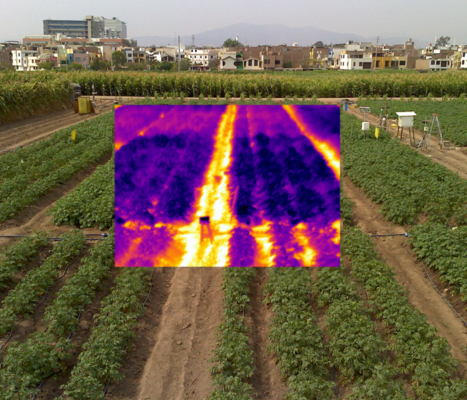

By George Munene
Scientists from the International Potato Center (CIP) have shown that the use of thermal imagery to measure the water stress of potato plants and precise irrigation according to crop stress can produce good harvests with less water.
At 70 per cent, agriculture is the activity that consumes the highest quantity of fresh water globally. With only three per cent of earth’s water being freshwater and climate change making its supply increasingly limited, there’s a growing water crisis in agriculture making irrigation methods for saving and conserving water a necessity.
These methods must however guarantee an appropriate yield with economic benefit to the farmer.
In a series of field studies in Peru, the scientists from CIP and other institutions monitored potato foliage temperature with infrared sensor cameras and applied a crop water stress index to determine when they needed watering. By balancing irrigation and plant stress the researchers were able to optimize both potato yield and water use.
Related News: Dealing with potato late blight– the most devastating disease for farmers
Related News: European companies capture Kenya’s potato seed sector impoverishing farmers
The researchers used the red-skinned heat and drought-tolerant Unica potato that has gained popularity in Latin America, Africa, and Asia.
They documented significantly reduced water usage in both furrow and drip irrigation systems.
The optimisation of water they noted is also crucial as improper irrigation management and governance is one of the leading causes of land degradation, promoting salinization and the reduction of water productivity in crops.
According to CIP, the key aspect of this study is the use of a holistic assessment. By considering more than just yield, the model integrated economic benefits and environmental indicators such as water use and carbon footprint. This found that furrow irrigation under medium stress conditions did not significantly reduce yield, had lower production costs, and comparable total carbon emissions relative to drip irrigation.
“The integrated index we propose can be used for a holistic assessment of any technology. In addition to water management, it can be used in breeding, seed system management, or other agronomic activities,” said co-author David Ramírez, leader of CIP’s Crop Ecophysiology and Modelling Laboratory.
Related News: Partial Root-Zone Drying irrigation enables potato farmers halve water usage
While Ramírez and colleagues used a portable photosynthesis system and handheld thermal cameras in this study, he noted that the approach can be scaled up using remote sensing technology, such as drone- or satellite-based thermal imagery, to estimate stress thresholds in crops and inform water management decisions.
Potatoes are the third most crucial edible crop worldwide and are considered one of the most effective water-use crops because of their higher energy produced per water volume– higher than rice, maize, and other crops.
Due to its low carbon emissions and water use, the potato is a highly regarded staple crop. Thus, potato cultivation replacing other higher greenhouse gas emitter crops (such as rice) is considered an appropriate alternative to mitigate climate change in the future.